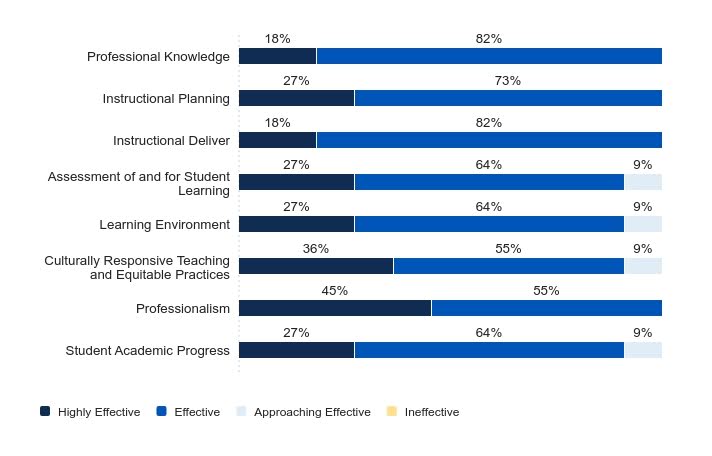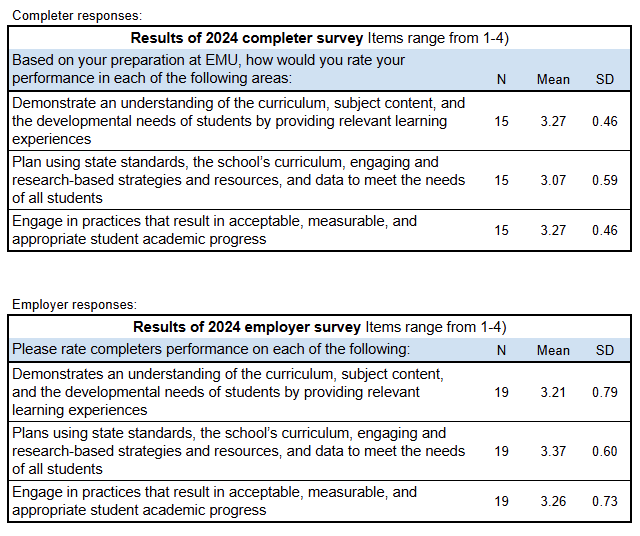CAEP Accountability Measures
CAEP (Council for the Accreditation of Educator Preparation) requires Educator Preparation Programs (EPPs) to provide program accountability measures to the public. Below are the accountability measures for our initial licensure programs. Advanced level licensure program data is not reported due to the personally identifiable nature of information for fewer than 10 completers.
The mission of the EMU Teacher Education Program is to prepare competent, caring, reflective practitioners who advocate for children and youth, develop caring learning environments, initiate and respond creatively to change, value service to others, and teach boldly in a changing world through an ethic of care and critical reflection.
Impact Measures (CAEP Standard 4)
Each year the teacher education program surveys program completers and their employers to get their perceptions on how well the program prepared them for their job responsibilities, and how satisfied they are with their preparation for teaching. The program also asks completers to self-report the results of their annual “Teacher Summative Performance Evaluations” which are completed by administrators in Virginia public schools. The program primarily uses these measures as the measures of impact and satisfaction.
Measure 1: Completer Impact and Effectiveness
In-service teachers in Virginia are evaluated annually on eight professional standards. One of the professional standards is “Student Academic Progress”. Responses from the 2023 and 2024 survey administration have been combined due to low response rates. Of the responses received in 2023 and 2024, 91% of respondents received a rating of “effective” or “highly effective” in the area of impacting student academic progress.

___________________________________________________________________
Results from the 2024 completer and employer surveys also indicate that completers were adequately prepared to positively impact student learning.

These data demonstrate that program completers positively impact P-12 student learning growth and effectively apply professional knowledge, skills, and dispositions.
Measure 2: Satisfaction of Employers and Stakeholder Involvement
Results from the 2024 initial licensure employer surveys indicated a high level of satisfaction by employers on completers’ ability to meet the needs of students in their school.

Advanced level licensure program employer survey data is not reported due to the personally identifiable nature of information for programs with low numbers.
In addition to gathering survey results from employers, the program involves external stakeholders in program decisions through its Committee on Teacher Education (COTE). In addition to teacher education faculty, COTE is composed of discipline-specific faculty members from outside of the teacher education program, two student representatives, and three representatives from local school divisions. During the 2023-2024 academic year COTE had three meetings. The following were topics of discussion or actions taken during these COTE meetings:
- To solicit input from internal and external stakeholders on program policies and assessment instruments.
- To review and approve revised Admission to Teacher Education, Admission to Student Teaching, and Exit Requirements.
- To analyze data from the Completer/Employer Survey and Impact Form Survey, and recommend
changes to the EPP.
Additionally,
- COTE representatives, P-12 administrators and faculty, and EPP faculty conduct focus group interviews of all candidates applying for admission to teacher education.
- The MidValley Consortium which consists of partners from four EPPs and seven P-12 school divisions meet monthly to coordinate clinical faculty trainings, create/revise student teaching evaluations and observation form, and to collaboratively place student teachers across the seven school districts.
Measure 3: Candidate Competency at Program Completion
Initial teacher education candidates complete a semester-long student teaching experience at the end of their program. Their final performance is evaluated on 32 criteria by both their P-12 teacher (cooperating teacher) and a university representative (university consultant). They are evaluated using a 4 point scale (Does not meet expectations, developing toward expectations, meets expectations, exceeds expectations), and the target rating by the end of student teaching is to receive a rating of “meets expectations” or better. This target was established by the MidValley Consortium, a collaboration of four universities and 7 school divisions. For 2023-24, cooperating teachers and university consultants ranked student teachers as Meets or Exceeds expectations 81% of the time across all evaluation items.
All candidates are required to take a Praxis Subject Assessment to demonstrate competence in their area of study. The initial teacher preparation program requires that candidates pass their subject exam in order to complete their program. Therefore, 100% of all 2023-24 program completers passed their Praxis Subject Assessment.
Advanced level licensure program data is not reported due to the personally identifiable nature for programs with low numbers.
Measure 4: Ability of Completers to be Hired in Education Positions for Which They Have Been Prepared
The program collects information on job placement directly from completers primarily
through ongoing contact maintained with completers. For the past five years, 100% of undergraduate initial program completers who sought positions in education
were employed in PreK-12 education settings.
88% of the 2023-24 completers seeking a job in the field were employed in an education position for which they were prepared while at EMU.
Triangulating data from Measure 4 with employer satisfaction data from Measure 2 shows that EPP completers are highly sought after and employers are very satisfied with the effectiveness of the program’s completers.
Advanced level licensure program data is not reported due to the personally identifiable nature for programs with low numbers.


